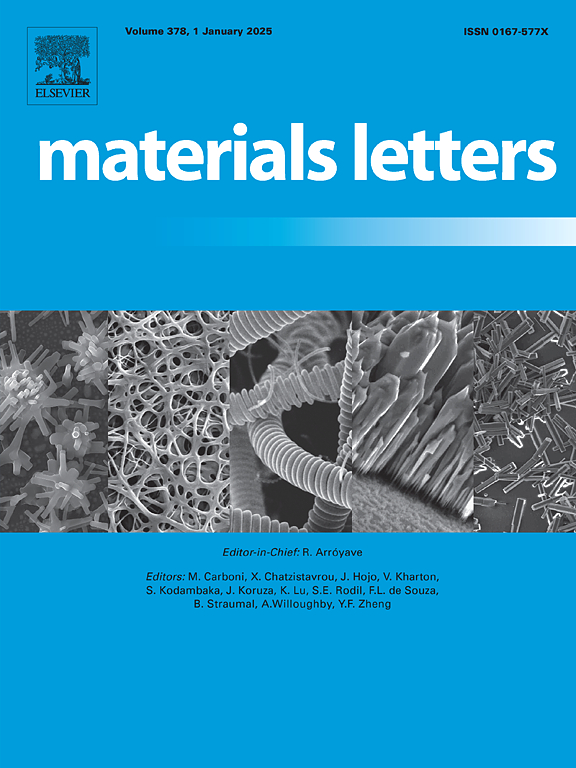Efficient synthesis of FeVO4 cathode materials in high specific energy thermal batteries
IF 2.7
4区 材料科学
Q3 MATERIALS SCIENCE, MULTIDISCIPLINARY
引用次数: 0
Abstract
Thermal batteries, which are essential for applications in extreme environments, require cathode materials with high specific energy and thermal stability. In this study, metal vanadates were synthesized via a chemical precipitation method followed by high-temperature sintering, offering a promising alternative for conventional transition metal sulfides. The synthesized FeVO4 exhibits phase purity, while copper and nickel vanadates show secondary phases, indicating challenges in achieving pure-phase synthesis of metal vanadates. Electrochemical evaluations reveal that FeVO4 cathode delivers an initial discharge voltage of 2.65 V and a specific capacity of 190 mAh/g. Whereas the FeVO4/CNTs composite cathode demonstrates an enhanced specific capacity of 253.66 mAh/g, which is attributed to prolonged discharge plateaus. Phase evolution studies indicated that FeVO4 reacts with molten salts during high-temperature discharge, leading to the formation of Fe2O3 and Li0.3V2O5, which contribute to the observed stepwise discharge behavior. These results emphasize the importance of optimizing the interactions between cathode materials and molten salts to improve the performance of high-temperature thermal batteries.
高效合成高比能量热电池中的 FeVO4 正极材料
在极端环境下应用的热电池需要具有高比能量和热稳定性的阴极材料。本研究通过化学沉淀法合成了金属钒酸盐,然后进行高温烧结,为传统的过渡金属硫化物提供了一种很有前景的替代材料。合成的 FeVO4 显示出相纯度,而铜和镍钒酸盐则显示出次生相,这表明实现金属钒酸盐的纯相合成面临挑战。电化学评估显示,FeVO4 阴极的初始放电电压为 2.65 V,比容量为 190 mAh/g。而 FeVO4/CNTs 复合阴极的比容量则提高到 253.66 mAh/g,这归因于放电高原的延长。相演化研究表明,在高温放电过程中,FeVO4 与熔盐发生反应,形成了 Fe2O3 和 Li0.3V2O5,从而导致了观察到的阶跃放电行为。这些结果表明,优化正极材料与熔盐之间的相互作用对于提高高温热电池的性能非常重要。
本文章由计算机程序翻译,如有差异,请以英文原文为准。
求助全文
约1分钟内获得全文
求助全文
来源期刊

Materials Letters
工程技术-材料科学:综合
CiteScore
5.60
自引率
3.30%
发文量
1948
审稿时长
50 days
期刊介绍:
Materials Letters has an open access mirror journal Materials Letters: X, sharing the same aims and scope, editorial team, submission system and rigorous peer review.
Materials Letters is dedicated to publishing novel, cutting edge reports of broad interest to the materials community. The journal provides a forum for materials scientists and engineers, physicists, and chemists to rapidly communicate on the most important topics in the field of materials.
Contributions include, but are not limited to, a variety of topics such as:
• Materials - Metals and alloys, amorphous solids, ceramics, composites, polymers, semiconductors
• Applications - Structural, opto-electronic, magnetic, medical, MEMS, sensors, smart
• Characterization - Analytical, microscopy, scanning probes, nanoscopic, optical, electrical, magnetic, acoustic, spectroscopic, diffraction
• Novel Materials - Micro and nanostructures (nanowires, nanotubes, nanoparticles), nanocomposites, thin films, superlattices, quantum dots.
• Processing - Crystal growth, thin film processing, sol-gel processing, mechanical processing, assembly, nanocrystalline processing.
• Properties - Mechanical, magnetic, optical, electrical, ferroelectric, thermal, interfacial, transport, thermodynamic
• Synthesis - Quenching, solid state, solidification, solution synthesis, vapor deposition, high pressure, explosive
 求助内容:
求助内容: 应助结果提醒方式:
应助结果提醒方式:


